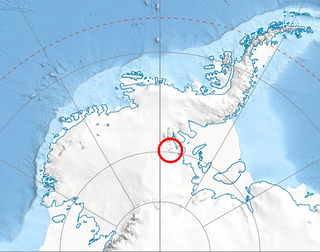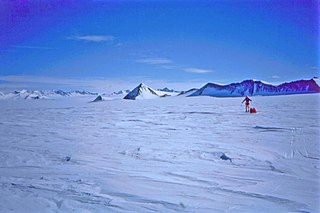
The Independence Hills are a line of rugged hills and peaks, 10 miles (16 km) long, with mainly bare rock eastern slopes. They lie 3 miles (5 km) southeast of the Marble Hills and form the southern segment of the west wall of Horseshoe Valley, in the Heritage Range of Antarctica. The Independence Hills were mapped by the United States Geological Survey from ground surveys and U.S. Navy air photos, 1961–66. The name was applied by the Advisory Committee on Antarctic Names in association with the name "Heritage Range".

Union Glacier, is a large, heavily crevassed glacier which receives the flow of several tributaries and drains through the middle of the Heritage Range, Ellsworth Mountains, Antarctica. The glacier drains from the plateau at Edson Hills on the west side of the range and flows east between Pioneer Heights and Enterprise Hills. Union Glacier was mapped by U.S. Geological Survey (USGS) from surveys and U.S. Navy (USN) air photos, 1961-66. The name was applied by Advisory Committee on Antarctic Names (US-ACAN) in association with the name Heritage Range.
The Buchanan Hills are a cluster of rugged hills standing north of Union Glacier and between the Collier Hills and the Nimbus Hills, in the Heritage Range. They were named by the Advisory Committee on Antarctic Names for Roger Buchanan, United States Antarctic Research Program biologist in Antarctica in the 1964–65 season.
Urban Point is a sharp rock point lying 2 nautical miles (3.7 km) east of the terminus of Ahrnsbrak Glacier on the north side of the Enterprise Hills, Heritage Range. Mapped by United States Geological Survey (USGS) from surveys and U.S. Navy air photos, 1961-66. Named by Advisory Committee on Antarctic Names (US-ACAN) for Verdis D. Urban, meteorologist with the Ellsworth Station winter party, 1958.
Nimbus Hills is a rugged line of hills and peaks about 14 nautical miles (26 km) long, forming the southeast part of Pioneer Heights in the Heritage Range, Ellsworth Mountains. Mapped by United States Geological Survey (USGS) from ground surveys and U.S. Navy air photos, 1961-66. Named by Advisory Committee on Antarctic Names (US-ACAN) after the National Aeronautics and Space Administration weather satellite, Nimbus, which took photographs of Antarctica from approximately 500 nautical miles (900 km) above earth on September 13, 1964.
Strong Peak is a small sharp peak at the end of a ridge in the Enterprise Hills, standing 3 nautical miles (6 km) west-southwest of Parrish Peak and overlooking the head of Horseshoe Valley, Heritage Range. It was mapped by the United States Geological Survey (USGS) from surveys and U.S. Navy air photos from 1961-66. It was named by the Advisory Committee on Antarctic Names (US-ACAN) for Jack E. Strong, a United States Antarctic Research Program (USARP) biologist at Palmer Station in 1965.
Guarcello Peak is a peak, 2,050 metres (6,730 ft) high, located 3.5 nautical miles (6 km) south-southeast of Mount Dolence in the Enterprise Hills of the Heritage Range in Antarctica. It was mapped by the United States Geological Survey from surveys and U.S. Navy air photos from 1961–66, and was named by the Advisory Committee on Antarctic Names for Dominic Guarcello, a meteorologist at Little America V Station in 1958. Guarcello Peak was first successfully climbed on December 23, 2011 by Simon Abrahams, Ralf Laier and Todd Passey.
Pioneer Heights is a group name in the Heritage Range, Ellsworth Mountains, encompassing the large area of hills, ridges and peaks located eastward of Schneider and Schanz Glaciers and between Splettstoesser and Union Glaciers. Among these features are the Inferno Ridge, the Nimbus Hills, Gross, Buchanan and Collier Hills. The Pioneer Heights were mapped by the United States Geological Survey (USGS) from ground surveys and U.S. Navy air photos from 1961-66. The name was applied by the Advisory Committee on Antarctic Names (US-ACAN) in association with the name Heritage Range.

Plummer Glacier is a short glacier descending east through the Enterprise Hills to the north of Lippert Peak and the Douglas Peaks, in the Heritage Range in Antarctica. Mapped by United States Geological Survey (USGS) from surveys and U.S. Navy air photos, 1961-66. Named by Advisory Committee on Antarctic Names (US-ACAN) for Charles C. Plummer, United States Antarctic Research Program (USARP) glaciologist at Palmer Station in 1965.
Parrish Peak is a very pointed, partly snow-topped peak, 1,775 m, surmounting the ridge next south of Seal Glacier in the Enterprise Hills, Heritage Range. It was mapped by the United States Geological Survey (USGS) from surveys and U.S. Navy air photos from 1961-66. It was named by the Advisory Committee on Antarctic Names (US-ACAN) for Edward N. Parrish, a glaciologist on the United States Antarctic Research Program (USARP) South Pole—Queen Maud Land Traverse I and II, 1964–65 and 1965-66.

Flanagan Glacier is a glacier in the Pioneer Heights of the Heritage Range, Antarctica, draining east from Thompson Escarpment between the Gross Hills and the Nimbus Hills to the confluent ice at the lower end of Union Glacier. It was mapped by the United States Geological Survey from surveys and U.S. Navy air photos, 1961–66, and was named by the Advisory Committee on Antarctic Names for Lieutenant Walter B. Flanagan, an assistant maintenance officer with U.S. Navy Squadron VX-6 at McMurdo Station during Operation Deep Freeze 1963 and 1964.

Henderson Glacier is a glacier about 7 nautical miles long in the Enterprise Hills of the Heritage Range, Antarctica. It flows northeast from Schoeck Peak and Hoinkes Peak to enter Union Glacier just east of Mount Rossman. Henderson Glacier was mapped by the United States Geological Survey from surveys and U.S. Navy air photos 1961–66, and was named by the Advisory Committee on Antarctic Names for Felix E. Henderson, a United States Antarctic Research Program meteorologist at Eights Station in 1965.
The Marble Hills are a group of mainly ice-free hills in West Antarctica. They are located on the west side of Horseshoe Valley, between the Liberty Hills and Independence Hills in the southern part of the Heritage Range, Ellsworth Mountains. The hills were named by the University of Minnesota Ellsworth Mountains Party, 1962–63, because the rocks in these hills are composed of marble.
Hoinkes Peak is a sharp rock peak, 1,840 metres (6,040 ft) high, standing at the head of Henderson Glacier, where it forms part of the west wall of the glacier, in the Heritage Range, Antarctica. It was mapped by the United States Geological Survey from surveys and U.S. Navy air photos from 1961–66, and was named by the Advisory Committee on Antarctic Names for Herfried C. Hoinkes, a meteorologist at Little America V Station in 1957.
Sutton Peak is a sharp peak, 1,410 metres (4,630 ft) high, on the ridge separating Henderson Glacier and Ahrnsbrak Glacier in the Enterprise Hills, Heritage Range. It was mapped by the United States Geological Survey from surveys and from U.S. Navy air photos, 1961–66, and named by the Advisory Committee on Antarctic Names for Walter C. Sutton, meteorologist at Little America V Station during 1957.

The Liberty Hills are a line of rugged hills and peaks with bare rock eastern slopes, about 10 nautical miles (19 km) long, standing 7 nautical miles (13 km) northwest of the Marble Hills and forming part of the west wall of Horseshoe Valley, in the Heritage Range, Ellsworth Mountains, Antarctica. The Liberty Hills were mapped by the United States Geological Survey from ground surveys and U.S. Navy air photos, 1961–66. The name was applied by the Advisory Committee on Antarctic Names in association with the name Heritage Range. The remarkable High Nunatak towers east of the Hills.







